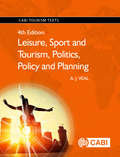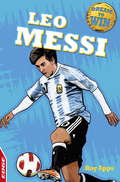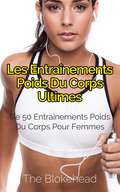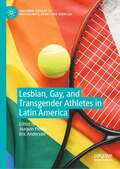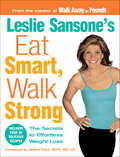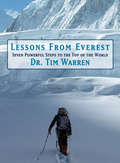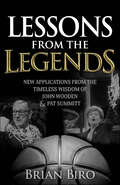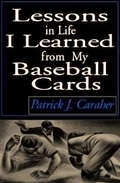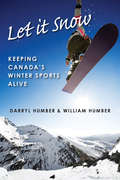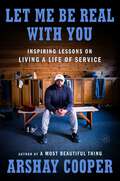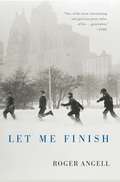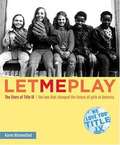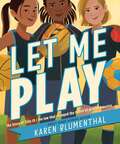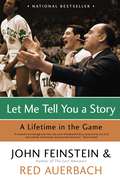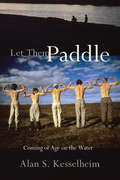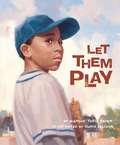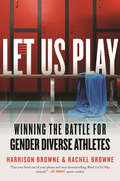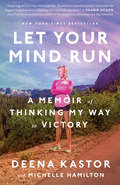- Table View
- List View
Leisure, Sport and Tourism, Politics, Policy and Planning 4th Edition
by A. J. VealA comprehensive, multi-disciplinary approach to public policy making and planning in the leisure, sport, and tourism sectors, this book provides an introduction to the subject for undergraduate and postgraduate students. It examines the theoretical issues underpinning public sector policy making such as political ideologies, leisure wants, needs, demand, and benefits, and human rights in leisure, sport, tourism, and culture. Also discussing the debates surrounding the role of the state versus market and the models of organizational decision-making, it uses applied sections addressing strategic planning and performance evaluation to provide a link between theory and practical analytical techniques.
Leo Messi
by Roy Apps Chris KingWe've all got a dream, right? <P><P> Growing up in Rosario, Argentina was tough for a kid - especially a little one like Lionel Messi. But Lionel didn't want to be little - he wanted to be a LEGEND! <P>This is the story of Lionel's discovery, his first football matches for Newell's Old Boys and then the huge decision that would change his life FOREVER... <P>It takes blood, sweat and tears to get to the top of any sport, and these short, inspirational biographies show just how tough it can be. <P>Each is written by expert author Roy Apps for kids with a reading age of 7 (but could also be enjoyed by pre-teens) and illustrated with black-and-white artwork. <P>The stories focus on top athletes and sport personalities, with each dramatic story bringing to life the skill, determination and luck needed to break through into top level competition.
Leo Messi (EDGE: Dream to Win #18)
by Roy AppsWe've all got a dream, right? Growing up in Rosario, Argentina was tough for a kid - especially a little one like Lionel Messi. But Lionel didn't want to be little - he wanted to be a LEGEND! This is the story of Lionel's discovery, his first football matches for Newell's Old Boys and then the huge decision that would change his life FOREVER...It takes blood, sweat and tears to get to the top of any sport, and these short, inspirational biographies show just how tough it can be. Each is written by expert author Roy Apps for kids with a reading age of 7 (but could also be enjoyed by pre-teens) and illustrated with black-and-white artwork. The stories focus on top athletes and sport personalities, with each dramatic story bringing to life the skill, determination and luck needed to break through into top level competition.This title is published by Franklin Watts EDGE, which produces a range of booksto get children reading with confidence. EDGE - for books kids can't put down.
Leprechauns Don't Play Basketball (The Adventures of the Bailey School Kids #4)
by Debbie Dadey Marcia Thornton JonesThe visiting teacher, was short, dressed in a red jump suit, and carrying a small pouch of gems on his waist. And he was not quite right. The kids at Bailey School think he might be a Leprechaun. And why does Mrs. Jeepers dislike the leprechauns so much. Can the kids solve this mystery in time?
Les entraînements poids du corps ultimes: + de 50 entraînements poids du corps pour femmes
by The BlokeheadMerci, et félicitations d'avoir téléchargé le livre « Les entraînements poids du corps ultimes : + de 50 entraînements poids du corps pour femmes ». Ce livre contient les étapes et stratégies pour comprendre les concepts inhérents au renforcement musculaire pour les femmes. Toutes les études récentes ont démontré que c'est le renforcement musculaire, et non pas la cardio, qui permet de développer un corps sain et fort et de perdre efficacement de la graisse. Avec ce livre, vous verrez les préjugés fréquents liés au renforcement musculaire chez les femmes et comment ils sont réfutés avec des faits. Achetez le livre maintenant !
Lesbian, Gay, and Transgender Athletes in Latin America (Palgrave Studies in Masculinity, Sport and Exercise)
by Eric Anderson Joaquín PiedraThis edited volume draws upon work from a wide range of established and emerging international scholars to provide an interdisciplinary analysis of sport’s complex relationship with masculinity. With a particular focus on Latin America, it examines the changing relationship between a range of contemporary sport and sexuality and gender expression, as related to lesbian, gay and/or trans athletes. Experts from Spain, Argentina, Brazil, Mexico, and Colombia provide historical, sociological and anthropological perspectives on heteronormativity, masculinity, gender identity, sexual orientation, and the gender binary as they relate to sports clubs, Mexican martial arts, football, softball, sports media, games, and physical education. It will be invaluable to scholars and students in the fields of Gender Studies, Queer Studies, Sports Studies, and Men’s Studies.
Leslie Sansone's Eat Smart, Walk Strong: The Secrets to Effortless Weight Loss
by Leslie SansoneA bestselling fitness guru turns her expertise and experience to teaching her fans how to develop the healthy eating habits that have worked for her. Her proven six-week plan allows readers to experiment with different methods and adopt the healthy habits that are most effective for them.
Lesson Plans for Dynamic Physical Education for Elementary School Children
by Robert P. PangraziThree complete sets of lesson plans are included to cover three major developmental levels.
Lessons for Lauren (Riding Academy #4)
by Alison HartSpunky Laren Remick is everyone's best friend, the suite's cheerleader, and sometimes peacemaker. But when the girls receive their mid-semester grades, she isn't sure she'll be allowed to continue at Foxhall. To Lauren's relief, her adviser suggests a student tutor, Courtney Stewart. At first, Lauren idolizes the smart, popular girl. But then she finds out that Courtney isn't so perfect, after all.
Lessons from Everest: Seven Powerful Steps to the Top of the World
by Dr Tim Warren"Into Thin Air" meets "The Secret" with a splash of humor! After a devastating failed attempt to climb Mt. Everest in 2007 and a brief period of mourning, Dr. Tim Warren became focused on learning the lessons that had been revealed to him while hiking alone for three days down the Khumbu Valley of Nepal to heal his damaged lung tissue in the luxury of oxygen-rich lower altitude. He felt an overpowering desire to return to the mountain the next year and experienced a clear vision of himself at the summit and arriving safely back in base camp. After testing those lessons over the next year-and-a-half, and within an inch of his life, he achieved this goal. Equally importantly, he realized that the lessons learned on the "Big E" were universal to people seeking to overcome difficulties in life or simply to edge a little closer to their full potential. Lessons From Everest describes seven lessons, each a stepping stone to greater understanding and awareness of the reader's inner journey to their own Everest with a healthy dose of seat-of-your-pants adventure.
Lessons from the Legends: New Applications from the Timeless Wisdom of John Wooden and Pat Summitt
by Brian BiroNCAA and SEC championship-winning American college basketball coaches Pat Summitt and John Wooden exemplified the essential values of humility, loyalty, encouragement, respect, honesty, confidence, curiosity, and the competitive spirit—to name a few. Lessons from the Legends shares the teachings of these renowned coaches at a time when “WE-GO, not ego” is more important than ever before. Professional speaker and motivator Brian Biro brings together the championship teambuilding formula of Pat Summitt and John Wooden in his latest release, Lessons from the Legends. Biro describes the impact of these modern-day heroes, how their drive and integrity generated remarkable results. Though Biro points out that these two coaching legends were quite different in personality and approach—one all passion and intensity, the other calm and even-keeled—he highlights the significant characteristics they shared that set them apart as leaders. Biro explains that the foundational principles and coaching strategies of Pat Summitt and John Wooden can apply to teachers, business leaders, parents, and anyone else who strives to make their character their reputation. With real-life examples of professional coaches demonstrating resilience and determination in the face of ever-changing challenges, Lessons from the Legends provides a winning game plan for those who seek excellence over ego.
Lessons in Life I Learned from My Baseball Cards
by Patrick J. CaraherRemember when the most exciting moment of your childhood was opening a fresh pack of baseball cards? How you gazed lovingly at the pictures of your heroes, pored over their statistics, thrilled to their exploits and identified with their lives? We all know someone whose baseball card collection was the most significant touchstone of his childhood. Baseball card collector Patrick Caraher has turned his lifelong passion into a spiritual odyssey in Lessons in Life I Learned from Baseball Cards. Selecting some prize items from his collection, Caraher has reflected on their larger resonance and produced this little gem of a book, the sports equivalent of Everything I Need to Know I Learned in Kindergarten. With deft cameos of stars whose admirable lives and careers characterized such virtues as fortitude, humility, determination, honesty, and decency, Caraher has breathed life into the statistics behind baseball's role models and produced a collection of miniature portraits that illuminates the national pastime as few other books have.
Lessons in the Art of War
by Martina SpragueWar is a human activity, not one that is limited by geographic location. And the principles of war are the same, regardless of place or number of participants. An army of ten thousand engaged in battle uses the same basic strategies that two people in single combat will utilize.In Lessons in the Art of War, author Martina Sprague explores the writings of both Sun Tzu, the famous Chinese military strategist, and Carl von Clausewitz, the European military genius. Despite the differences in time period, geographic location and culture, both Sun Tzu and von Clausewitz had achieved extraordinary understanding of human nature and how that relates to combat. Sprague takes the similarities and differences in their respective strategies and distills them down to their essence for martial artists to understand and incorporate into their personal practices.
Lessons in the Art of War
by Martina SpragueWar is a human activity, not one that is limited by geographic location. And the principles of war are the same, regardless of place or number of participants. An army of ten thousand engaged in battle uses the same basic strategies that two people in single combat will utilize.In Lessons in the Art of War, author Martina Sprague explores the writings of both Sun Tzu, the famous Chinese military strategist, and Carl von Clausewitz, the European military genius. Despite the differences in time period, geographic location and culture, both Sun Tzu and von Clausewitz had achieved extraordinary understanding of human nature and how that relates to combat. Sprague takes the similarities and differences in their respective strategies and distills them down to their essence for martial artists to understand and incorporate into their personal practices.
Let It Snow: Keeping Canada's Winter Sports Alive
by William Humber Darryl HumberWinter has shaped Canada’s image and has been embraced with hearty enthusiasm from snowshoeing hikers in the nineteenth century, to future hockey stars on backyard rinks, to the indoor spectacle of figure-skating carnivals and curling bonspiels. Much of our literature, our songs, and our memories of youth reflect the bracing tonic that winter brings even as we curse the ice-laden roads on morning commutes or during weekend ski trips. But alas, winter’s demise to a weak reminder of its former glory is a real possibility as climate change wreaks long-term havoc. This timely book takes a fond look at winter’s past, its place in Canada’s story, and how it has shaped our sports history. It also explores what climate change means for our sense of Canadian identity, for our winter sports heritage and its related industries, and for our ability to hold winter sporting events beyond the 2010 Winter Olympics in Vancouver.
Let Me Be Real with You: Inspiring Lessons on Living a Life of Service
by Arshay CooperFrom the celebrated athlete and award-winning author, an inspirational collection of personal stories and lessons that will spark change within you and transform how you contribute to the world.Arshay Cooper believes in bringing people together, seeking out opposing ideas to collaborate and find consensus rather than focusing on differences and “othering.” In Let Me Be Real with You, he reflects on his personal journey—from the trials he faced as a young Black boy from the West Side of Chicago to finding international recognition as an athlete and philanthropist—sharing insights to guide you on your own journey.The stories in Let Me Be Real with You will help you navigate difficulties and challenges with grace, awareness, hope, and even humor, and fortify your commitment to a life lived in service to others without sacrificing your own self-care. Arshay introduces you to the eight essential tenets of wellness—mental, physical, environmental, vocational, financial, intellectual, social, and spiritual—and teaches you how to incorporate them into daily life. You'll discover:How to tell and own your stories.The importance of unlearning so you can learn.The balance between pushing yourself and recovery.Cooper reveals how a wellness mindset and practices became an integral part of his life and success and how they can become central to yours as well. A memoir and inspirational guide, Let Me Be Real with You is for all of us who want to change our lives and find the courage to “do it afraid."
Let Me Finish
by Roger AngellEssays from the award-winning New Yorker writer and author of This Old Man: &“Witty, worldly, deeply elegiac, and…heartbreaking.&”—The Boston Globe For more than fifty years, as both editor of and contributor for The New Yorker, Roger Angell has honed a reputation as a master of the autobiographic essay—sharp-witted, plucky, and at once nostalgic and unsentimental. In Let Me Finish, Angell reflects on a remarkable life (while admitting to not really remembering the essentials) and on its influences large and small—from growing up in Prohibition-era New York, to his boyhood romance with baseball, to crossing paths with such twentieth-century luminaries as Babe Ruth, John Updike, Joe DiMaggio, S.J. Perelman, and W. Somerset Maugham. He discusses his dread of Christmas, a revealing recurring dream, and his stepfather, E.B. White. He recalls glorious images from the movies he saw as a child (for which Angell has a nearly encyclopedic memory), the sheer bliss of sailing off the coast of Maine, and the even greater pleasure of heading home to the perfect 6 p.m. vodka martini. Personal, reflective, funny, delightfully random, and disarming, this is a unique collection of scenes from a life by the New York Times bestselling author of The Summer Game, &“one of the most entertaining and gracious prose stylists of his…generation&” (Time). &“A lovely book and an honest one…about loyalty and love, about work and play, about getting on with the cards that life deals you. It's also a genuinely grown-up book, a rare gem indeed in our pubescent age.&”—The Washington Post
Let Me Play: The Story of Title IX, the Law That Changed the Future of Girls in America
by Karen BlumenthalIn 1972, Congress passed a modest little law called Title IX, that said any school receiving money from the government couldn't treat boys and girls differently because of their sex. For the first time, girls across the United States got a real chance to play on the athletic field - and that little law took on a role far greater than anyone ever imagined it could.
Let Me Play: The Story of Title IX: The Law That Changed the Future of Girls in America
by Karen BlumenthalCelebrate the 50th anniversary of Title IX, the law that opened the door for greater opportunities for girls and women, with this refreshed edition of the nonfiction illustrated middle grade book about an important victory in the fight for equality.Not long ago, people believed girls shouldn&’t play sports. That math and science courses were too difficult for them. That higher education should be left to the men. Nowadays, this may be hard to imagine, but it was only fifty years ago all of this changed with the introduction of the historical civil rights bill Title IX. This is the story about the determined lawmakers, teachers, parents, and athletes that advocated for women all over the country until Congress passed the law that paved the way for the now millions of girls who play sports; who make up over half of the country&’s medical and law students; who are on the national stage winning gold medals and world championships; who are developing life-changing vaccines, holding court as Supreme Court Justices, and leading the country as vice president. All because of Title IX and the people who believed girls could do anything—and were willing to fight to prove it. This updated edition of Let Me Play includes new chapters about how Title IX is being used in the fight for transgender rights and justice for sexual assault survivors and a refreshed epilogue highlighting the remarkable female athletes of today and the battles they&’re still fighting.
Let Me Tell You a Story: A Lifetime in the Game
by John Feinstein Red AuerbachAmerica's favorite sportswriter and the legendary Boston Celtics coach join forces to produce one of the most richly entertaining books ever written about the game of basketball. Auerbach colorfully recalls all the players and coaches he worked with and played against: Bill Russell, Larry Bird, Bob Cousy, Wilt Chamberlain, Sam Jones, and Michael Jordan--you name them, the basketball greats are here. John Feinstein has written two of the bestselling sports books of all time, A Season on the Brink and A Good Walk Spoiled, and his books have been a fixture on bestseller lists for the past two decades.
Let Them Paddle: Coming of Age on the Water
by Alan S. KesselheimWhen paddlers Alan S. Kesselheim and his wife were starting their family, each of their three kids unintentionally experienced, before birth, a major river expedition. <P><P>Later, Eli, Sawyer, and Ruby grew up on other river trips, joining the Kesselheims in canoes as infants and toddlers and becoming adept paddlers and campers before the age of ten. Recognizing a unique opportunity to celebrate their childrens' transitions to adulthood, the family returned to those "birth" rivers and repeated each of the three original paddling trips. Over a period of four years, as each child reached the age of thirteen, and across a span of geography from the Arctic Circle to Mexico, the family of five shared inspirational travel adventures on the water. A moving testimonial for allowing children to experience nature firsthand, Let Them Paddle is a captivating tale of a family coming of age. Alan S. Kesselheim has worked as a freelance writer for thirty years. He is the author of ten books and hundreds of magazine articles in a handful of publications, including Canoe & Kayak magazine. In addition to his writing work, Kesselheim has taught writing workshops throughout North America and teaches occasional classes at Montana State University. He is best known for his exploits as a wilderness adventurer and canoeist and is a veteran of many extended expeditions, including two year-long canoe journeys across Canada. Kesselheim has incorporated his three children into his wilderness adventure lifestyle and has every expectation that they will carry on the tradition. He lives in Bozeman, Montana, with his wife and children.
Let Them Play (Tales of Young Americans)
by Margot Theis Raven Chris Ellison<p>Segregated Charleston, SC, 1955: There are 62 official Little League programs in South Carolina -- all but one of the leagues is composed entirely of white players. The Cannon Street YMCA All-Stars, an all-black team, is formed in the hopes of playing in the state's annual Little League Tournament. What should have been a time of enjoyment, however, turns sour when all of the other leagues refuse to play against them and even pull out of the program. <p>As the only remaining Little League team in the state, Cannon Street was named state winner by default, giving the boys a legitimate spot in the Little League Baseball World Series held in Williamsport, Pennsylvania. While the Cannon Street team is invited to the game as guests, they are not allowed to participate since they have not officially "played" and won their state's tournament. <p>Let Them Play takes its name from the chant shouted by the spectators who attended the World Series final. Author Margot Theis Raven recounts the inspiring tales of the Cannon Street All-Stars as they arrived in Williamsport, PA and never got the chance to play for the title thanks to the bigotry and ignorance of the South Carolina teams. Winning by forfeit, the Cannon Streeters were subsequently not allowed to participate in Williamsburg because they had not "played" their way into the tournament. <p>Let Them Play is an important civil rights story in American history with an even more important message about equality and tolerance. It's a tale of humanity against the backdrop of America's favorite pastime that's sure to please fans of the sport and mankind. This summer will mark the 50th year since the fans' shouts of Let Them Play fell on deaf ears and 14 boys learned a cruel lesson in backwards politics and prejudice. <p>This book can help teach us a new lesson and assure something like this never happens again.</p>
Let Them Play: The Mindful Way to Parent Kids for Fun and Success in Sports
by Jerry LynchAmerican youth sports are in crisis: Parents are fighting with referees, coaches, their kids, and one another. Micromanaged kids are losing their passion to play. In Let Them Play, sports psychologist and team consultant Dr. Jerry Lynch provides an antidote to parental overinvolvement. Combining psychological insight with spiritual principles from Taoism and Buddhism, Lynch lays out core principles to help parents achieve equanimity and provide healthy direction for their kids. He gives parents strategies and tools taken from his work with national champions to help kids to perform at higher levels, become better team players, and most important, have more fun. Filled with easy-to-implement advice, Let Them Play will empower your athletic child to be mentally strong for sports and life.
Let Us Play: Winning the Battle for Gender Diverse Athletes (Queer Ideas/Queer Action)
by Harrison Browne Rachel BrowneA crucial subversion of the misconceptions around the participation of gender diverse athletes—advocating for the inclusion of trans and nonbinary athletes across all levels of sportThe debate over the inclusion of gender diverse people in sport has become the latest battleground in the fight for basic human rights and equality. Trans and nonbinary people around the world are facing physical harm and violence—including death—at unprecedented rates. In Let Us Play, trans athlete Harrison Browne and investigative journalist Rachel Browne reveal how the opposition towards gender diverse athletes is fueled by fear and a moral panic as opposed to facts around what makes &“a level playing field.&” Interweaving Harrison&’s first-hand experience as a transgender athlete with exclusive accounts—from athletes, coaches, policymakers, and advocates on the front lines—Let Us Play dismantles the illusion that sports have ever been fair, that trans athletes pose a threat to women&’s sports, and that gender-affirming healthcare for athletes should be prohibitive to play. Calling for a reframing of the binaries from youth and high school levels all the way to the national leagues, Browne and Browne offer a new path forward, led by solutions proposed by gender diverse athletes themselves.
Let Your Mind Run: A Memoir of Thinking My Way to Victory
by Deena Kastor Michelle HamiltonDeena Kastor was a star youth runner with tremendous promise, yet her career almost ended after college, when her competitive method—run as hard as possible, for fear of losing—fostered a frustration and negativity and brought her to the brink of burnout. On the verge of quitting, she took a chance and moved to the high altitudes of Alamosa, Colorado, where legendary coach Joe Vigil had started the first professional distance-running team. There she encountered the idea that would transform her running career: the notion that changing her thinking—shaping her mind to be more encouraging, kind, and resilient—could make her faster than she’d ever imagined possible. Building a mind so strong would take years of effort and discipline, but it would propel Kastor to the pinnacle of running—to American records in every distance from the 5K to the marathon—and to the accomplishment of earning America’s first Olympic medal in the marathon in twenty years.Let Your Mind Run is a fascinating intimate look inside the mind of an elite athlete, a remarkable story of achievement, and an insightful primer on how the small steps of cultivating positivity can give anyone a competitive edge.
